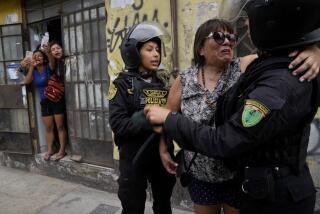100 facts for 100 years of Machu Picchu: Fact 15

- Share via
In July, Machu Picchu, Peru’s biggest tourist attraction, will mark its 100th anniversary of rediscovery. Hiram Bingham III, a Yale professor, came upon the vine-covered ruins on July 24, 1911. Here, then, as we lead up to the century mark, are 100-plus facts about Machu Picchu, its country, its history and its players. We will post one each day for the next 100 days.
15.Cuzco, with a population of about 300,000, is the gateway to Machu Picchu, but don’t let the word “gateway” confuse you: Machu Picchu is 50 miles beyond Cuzco NEAR the town of Aguas Calientes, far below the Incan ruins.
14. The symptoms of altitude sickness don’t generally present until you’re at 8,000 feet. Depending on which yardstick you use, Machu Picchu may be less than that (or more). Some say it’s at 7,100 feet; others say 9,000. Bottom line: Cut yourself a little slack.
13. To help cope with the altitude, make sure you don’t get dehydrated and avoid drinking alcohol.
12. Some hotels provide oxygen for visitors; others offer coca tea, and it’s not unusual to find packets of coca leaves for sale. These can be chewed and are said to help relieve altitude issues. And yes, cocaine is produced from the leaves, but the amount of the alkaloid you’d ingest from the tea or chewing the leaves is small.
11. Among the problems AMS can cause (if you’re coming from sea-level California, be aware of this): headaches, shortness of breath, fatigue and/or nausea or vomiting. Consult a doctor before you go if you think you may have a problem. Symptoms usually disappear in four days, but in some cases, AMS may be fatal.
10. At 11,150 feet, Cuzco requires acclimation. Some people develop altitude sickness, also known as acute mountain sickness, or AMS.
9. Cuzco, sometimes spelled Cusco, means “navel” or “center” of the Earth. It certainly was the center of Inca civilization high in the Andes Mountains.
8. Legend has it that Manco Capac, the son of the sun god, and Mama Ocllo, daughter of the moon, established the seat of what would become an empire at Cuzco in the 11th or 12th century.
7. Much of what we know -- or think we know -- about the Inca society is hazy and often mixes fact with myth.
6. Because the Incas had no written language system (or one that we have yet figured out), the spellings of original words vary widely. Inca, for example, may be spelled Inka, Ygna or Inga.
5. The Incas, who created incredible architecture and political systems, had no known written system of language, although some scientists suggest khipu may also have served that function.
4. The Inca used khipu (spelled “quipu” in Spanish), a series of knots that functioned as a sort of counting system.
3. About half the population of Peru is Quechua, a South American Indian group. The group’s native tongue is also called Quechua. A dialect of that language was spoken by the Incas.
2. Peru shares borders with five countries: Ecuador, Brazil, Bolivia, Chile and Colombia.
1. At 496,218 square miles, Peru, in western South America, is about the size of three Californias. California, however, has about 8 million more residents than Peru.
More to Read
Sign up for The Wild
We’ll help you find the best places to hike, bike and run, as well as the perfect silent spots for meditation and yoga.
You may occasionally receive promotional content from the Los Angeles Times.







